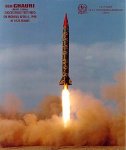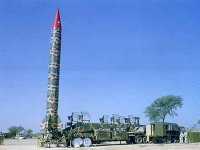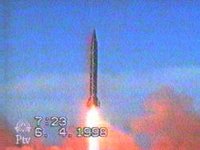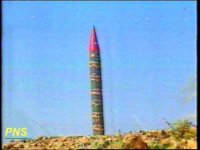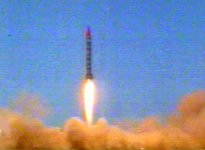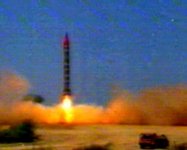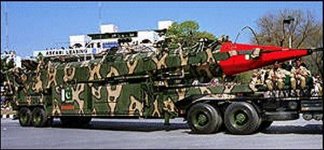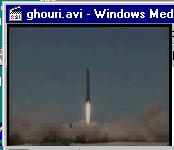






| Technical Details | |
| Range (km) | 1,350-1,500 |
| CEP (m) | 190 (Previously thought to be several thousand meters) |
| Diam. (m) | 1.32-1.35 |
| Height (m) | 15.852-16 |
| L. W. (kg) | 15,852-16,250 |
| Stage Mass (kg) | 15,092 |
| D. W. (kg) | 1,780-2,180 |
| Thrust (Kg f) | Effective: 26,051 (-709) Actual: 26,760-26,600 |
| Burn time (sec.) | 110 |
| Isp. (sec.) | Effective: 226 - SL due to vains steering drag loss of 4-5 sec. Actual: 230 Vac.: 264 |
| Thrust Chamb. | 1 |
| Fuel | TM-185 20% Gasoline 80% Kerosene |
| Oxidizer | AK-27I 27% N2O4 73% HNO3 Iodium Inhibitor |
| Propellant Mass (kg) | 12,912 |
| Warhead (kg) | 760-987-1,158 |
| Type | MRBM |
In the early 1980s China is widely reported to have provided Pakistan with the blueprints for a 1966 design of a U-235 nuclear-implosion device, of the type used in the warhead that China flew on a DF-2A missile during its fourth nuclear test on 27 October 1966. This missile warhead was reported to weigh about 1,300 kilograms with a yield of 12-25 kt. This warhead design would be too large to be carried on an M-11, which does not have the range to reach beyond the Indian Desert to threaten New Delhi or other large population centers. The Ghauri missile represents both an opportunity to use heavier uranium bombs on ballistic missiles, as well as to deliver nuclear warheads to targets across much of India. The Ghauri missile was developed by the Kahuta-based Khan Research Laboratories, led by Dr. A.Q. Khan, which is responsible for uranium weapons development.
Pakistan has stated that the range and payload capacity of the missile will be upgraded. Pakistan claimed that the missile had "no relevance" to China's M-11 missile, and analysis suggests that it appears to be a derivative of the North Korean Nodong design.This missile was first named Hataf-V, later the name was changed to Ghauri, which was approved by the prime minister. The missile was named after the 12th century Afghan king Shahbuddin Ghauri who captured western parts of India between 1176 and 1182, and captured northern India by defeating Prithvi Raj Chauhan in 1192. The Ghauri name is thus highly symbolic, as "Prithvi" is the name of the Indian short-range ballistic missiles, and Pakistan's "Ghauri" has a much longer range than the Indian missile.
On 06 April 1998 Pakistan carried out a successful flight test of the surface-to-surface Hatf-V (Ghauri) missile with a range of 1,500 kilometers (937 miles) and a payload capacity of 700 kg. The missile was tested to hit a target at a range of 1,100 kilometers. The Ghauri was fired from Malute, near the city of Jhelum in northeastern Pakistan, and impacted the target near the southwestern city of Quetta. This is a distance of only some 700 km, significanly less than the claimed range of up to 1,500 km/930 miles.
The Indian Test of the Agni II IRBM was conducted 11 April 1999. Pakistan responded on 14 Apr 1999 with a test firing of its Ghauri II missile from the Jhelum region in northeast Pakistan. The vehicle reportedly struck a target in the Baluchistan desert about 1,100 km. away.
It would appear that if the missile was fired directly due east, the effect of the earth's rotation would give it a range of 1,240 km. Fired in a southerly direction towards major urban targets in India, it could reach a range of some 950 km - 1,120 km. The US-based stratfor.com intelligence consulting company suggested that Pakistan may have test fired a missile [which could be a Ghauri] on 15 August 2000, when India was celebrating Independence Day. Objects streaking through the skies in Balucistan on that day were perhaps Ghauri-III missile tested by Islamabad, or perhaps they were merely a meteor shower.Developing Nations and Warhead Dynamic Performance
Recently, it was suggested that the developing nations missile program warheads would be tumbling about their center of gravity during re-entry, which would then make it difficult to identify. This was because they were not being spun-up along their longitudinal axis prior to re-entry through the atmosphere.
A warhead is much like a bullet fired from a rifle barrel. If the barrel is grooved to spin up the bullet along its longitudinal axis it tends to fly through the atmosphere to its target more smoothly and accurately. If the barrel is not built with this capability, the bullet tumbles uncontrollably about its center of gravity throughout its flight in the atmosphere to its target. This tumbling reduces the accuracy of the projectile.
This kind of missile warhead tumbling was noted in the ballistic flights of Iraqi's Scud-B, Scud-C/Al-Hussein, Scud-D/Al-Abbas ballistic missiles during the Gulf war. In this particular case all of the warheads remained attached to the Scud derived rocket bodies. The length of the Scud-C and D missile bodies and the failure to spin up either the missile with its warhead or separate the warhead after missile spin up made them extremely unstable and in accurate during re-entry to their target.
Today this is not the case with North Korean derived warhead technology. North Korea successfully demonstrated payload spin up with the satellite launch attempt of the Taep'o-dong-1 or PAEUTUSAN-1 booster. The Paeutusan-1 solid propellant third stage both demonstrated a near full duration burn and the spin up of the stage and satellite along its longitudinal axis. However, the third stage solid motor ruptured, de-orbiting the satellite, almost immediately after achieving orbital velocity.
Therefore, it would be correct to assume that besides North Korea's, No-dong (first stage of Taep'o-dong-1), both Pakistan's Ghauri-II and Iran's Shahab-3 all benefit from this spin-up technology. The Shahab-3/Ghauri-II both apparently spin up the single booster stage and warhead combination starting at about 10 seconds before the termination of the powered flight at 110 seconds. At this point after 110 seconds of powered flight the warhead is then separated from the booster stage to fly on a re-entry trajectory that remains stable to its target. With the addition of GPS targeting the warhead accuracy is greatly enhanced. There are still many in the analytical community that question, perhaps correctly, this suggested accuracy of 190 meters to over one kilometer. There can be no doubt that this spin-up technology does improve the accuracy of these warheads over the previously demonstrated poor capability. Since the warheads are not tumbling it in fact enhances the interceptor sensor signature identification capability verses that of a tumbling warheads signature.
Equally revealing is the fact that this is the area where the Iranian Shahab-3 has repeatedly failed in flight test. If the steering vains are not equally positioned correctly or are defective in any way the missile and warhead combination would tumble about its center of gravity out of control destroying the missile. The resulting tumbling warhead whether attached to the remaining missile body or not would in all probability be destroyed during its re-entry. It is known that Iran has and continues to suffer from a steering vain quality control problem for its Shahab-3 ballistic missile that the Germans during WW-II solved and that the United States and former Soviet Union were able to easily resolve with out using specialized coating.
